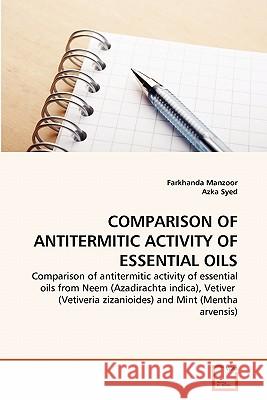Comparison of Antitermitic Activity of Essential Oils » książka
Comparison of Antitermitic Activity of Essential Oils
ISBN-13: 9783639348859 / Angielski / Miękka / 2011 / 112 str.
Present study deals with comparison of three essential oils (neem, vetiver and mint) against the most common termite species of Pakistan, Heterotermes indicola (Wasmann). Oils were tested for repellency, toxicity and fumigation against H. indicola. Results revealed that vetiver oil was most toxic killing 60% termites at 25 g/ l while neem and mint oils showed 54% and 56.66% mortality rate, respectively, at the same concentration. When tested for repellency, vetiver oil proved to be the most effective repellent because of its long lasting activity. In a fumigation test, all three oils were tested at concentration of 0.03125%, 0.0625%, 0.125%, 0.25% and 0.5%. Out of the three tested oils, vetiver oil was the most effective. The components of neem, vetiver and mint oil were identified by TLC technique. At the end of the study, it was concluded that vetiver oil is a promising novel termiticide against H. indicola."
Present study deals with comparison of three essential oils (neem, vetiver and mint) against the most common termite species of Pakistan, Heterotermes indicola (Wasmann). Oils were tested for repellency, toxicity and fumigation against H. indicola. Results revealed that vetiver oil was most toxic killing 60% termites at 25μg/μl while neem and mint oils showed 54% and 56.66% mortality rate, respectively, at the same concentration. When tested for repellency, vetiver oil proved to be the most effective repellent because of its long lasting activity. In a fumigation test, all three oils were tested at concentration of 0.03125%, 0.0625%, 0.125%, 0.25% and 0.5%. Out of the three tested oils, vetiver oil was the most effective. The components of neem, vetiver and mint oil were identified by TLC technique. At the end of the study, it was concluded that vetiver oil is a promising novel termiticide against H. indicola.











